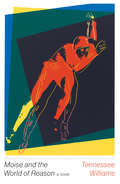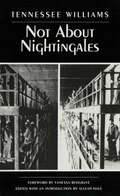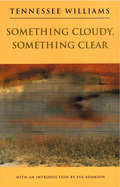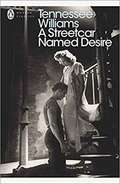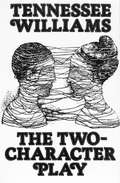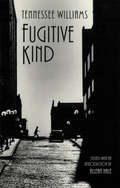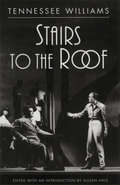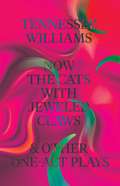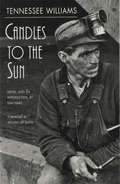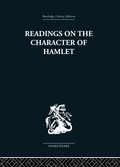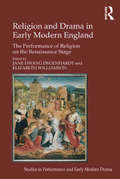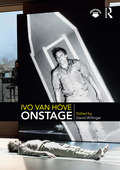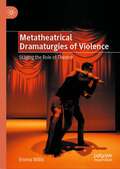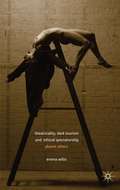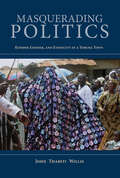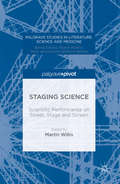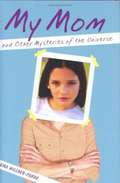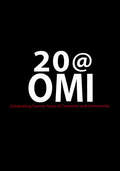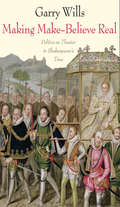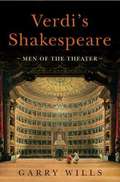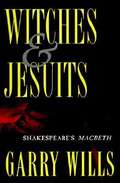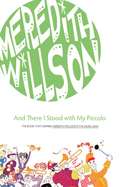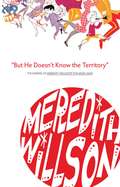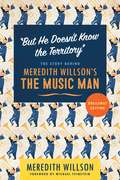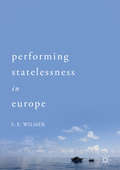- Table View
- List View
Moise and the World of Reason
by Tennessee WilliamsWhat's not to like about Tennessee Williams's most forthright work about homosexual love, with its gay figure skaters, runaways, and sex? An erotic, sensual, and comic novel that was a generation ahead of its time, Moise and the World of Reason has at its center the need of three people for each other: Lance, the beautiful black figure skater full of love and lust for young men as well as a craving for drugs; the nameless gay young narrator, a runaway writer from Alabama who lives near the piers of New York City's West Village, c. 1975, frantically filling notebooks with his observations; and Moise, a young woman who speaks in riddles and can never finish her paintings or consummate her affairs. The long unavailable Moise and the World of Reason represents a kind of uncensored Williams, radically frank, fully articulated, and deeply tender: a true gem.
Not About Nightingales
by Tennessee WilliamsThis early full-length play put a young Tennessee Williams' passion for social justice in the spotlight. "Haunting, searing, unforgettable" —London Herald In early 1998, sixty years after it was written, one of Tennessee Williams' first full-length plays, Not About Nightingales, was premiered by Britain's Royal National Theatre and was immediately hailed as "one of the most remarkable theatrical discoveries of the last quarter century (London Evening Standard). Brought to the attention of the director Trevor Nunn by the actress Vanessa Redgrave (who has contributed a Foreword to this edition), "this early work...changed our perception of a major writer and still packs a hefty political punch" (London Independent). Written in 1938 and based on an actual newspaper story, the play follows the events of a prison atrocity which shocked the nation: convicts leading a hunger strike in a Pennsylvania prison were locked in a steam-heated cell and roasted to death. Williams later said: "I have never written anything since that could compete with it in violence and horror." Its sympathetic treatment of black and homosexual characters may have kept the play unproduced in its own time. But its flashes of lyricism and compelling dialogue presage the great plays Williams has yet to write. Not About Nightingales shows us the young playwright (for the first time using his signature "Tennessee") as a political writer, passionate about social injustice, and reflecting the plight of outcasts in Depression America. The stylistic influences of European Expressionism, radical American theatre of the 1930s, and popular film make it unique among the group of four early plays. Not About Nightingales has been edited by eminent Williams scholar Allean Hale, who has also provided an illuminating historical introduction.
Something Cloudy, Something Clear
by Tennessee WilliamsTennessee Williams returns to a pivotal moment in his stormy youth in Something Cloudy, Something Clear, which introducer Eve Adamson calls "a delicately woven tapestry of past and present, vulnerability and toughness, impetuous action and mature insight." Something Cloudy, Something Clear is, as Tennessee Williams stated, "one of the most personal plays I’ve ever written." Set in Provincetown, Cape Cod, in 1940, the play records Williams’ experiences during that "pivotal summer when I took sort of a crash course in growing up." On the brink of becoming a successful playwright, Williams was also to "come thoroughly out of the closet" and meet Kip, his first great love. Something Cloudy, Something Clearbrilliantly reimagines that long ago time, now recollected through the filter of all the playwright’s successes and failures, joys and regrets. Eve Adamson, director of the original 1981 production, provides an insightful introduction in which she captures the play’s heart-breaking appeal: "It is a delicately woven tapestry of past and present, vulnerability and toughness, impetuous action and mature insight. It seeks a reconciliation between love and art, life and death, and-to use two phrases which recur in the play––exigencies of desperation and negotiation of terms. The cloudy and the clear."
A Streetcar Named Desire
by Tennessee WilliamsThe story of Blanche DuBois and her last grasp at happiness, and of Stanley Kowalski, the one who destroyed her chance.
The Two-Character Play
by Tennessee WilliamsA classic play by Tennessee Williams in a definitive, author-approved edition. Reality and fantasy are interwoven with terrifying power as two actors on tour--brother and sister--find themselves deserted by the trope in a decrepit "state theatre in an unknown state." Faced (perhaps) by an audience expecting a performance, they enact "The Two-Character Play"--an illusions within an illusion, and "out cry" from isolation, panic and fear. "I think it is my most beautiful play since Streetcar," Tennessee Williams said, "and I've never stopped working on it....It is a cri de coeur, but then all creative work,all life, in a sense is a cri de coeur." In the course of its evolution, several earlier versions of The Two-Character Play have been produced. The first of them was presented in 1967 in London and Chicago and brought out in 1969 by New Directions in a signed limited edition. The next, staged in 1973 in New York under the title Out Cry, was published by New Directions in 1973 The third version (New York, 1975), again titled The Two-Character Play, is the one Tennessee Williams wished to include in New Directions' The Theatre of Tennessee Williams series. It is this version which is presented in this ND paperback.
Fugitive Kind
by Tennessee Williams Allean HaleSocial outcasts, misfit survivors, dangerous passions—Tennessee Williams fleshed out the characters and themes that would dominate his later work in Fugitive Kind, one of his earliest plays. Fugitive Kind, one of Tennessee Williams's earliest plays, is one of his richest in dramatic material. Written in 1937 when the playwright was still Thomas Lanier Williams, Fugitive Kind introduces the character who will inhabit most of his later plays: the marginal man or woman who, through no personal fault, is a misfit in society but who demonstrates an admirable will to survive. Signature Tennessee Williams' characters, situations, and even the title (which was used as The Fugitive Kind for the 1960 film based on Orpheus Descending) have their genesis here. At age twenty-six, Williams was still learning his craft and this, his second full-length play, shows his debt to sources as diverse as thirties gangster films (The Petrified Forest, Winterset) and Romeo and Juliet. Fugitive Kind, with its star-crossed lovers and big city slum setting, takes place in a flophouse on the St. Louis waterfront in the shadow of Eads Bridge, where Williams spent Saturdays away from his shoe factory job and met his characters: jobless wayfarers on the dole, young writers and artists of the WPA, even gangsters and G-men. Fugitive Kind was also Williams's second play to be produced by The Mummers, a St. Louis theatre group devoted to drama of social protest. Called "vital and absorbing" by a contemporary review in The St. Louis Star-Times, this play reveals the young playwright's own struggle between his radical-socialist sympathies and his poetic inclinations, and signals his future reputation as our most compassionate lyric dramatist.
Stairs to the Roof
by Tennessee Williams Allean HaleA play produced only twice in the 1940s and now published for the first time reveals that Tennessee Williams anticipated the themes of Star Trek by decades. Sixty years ago a young Tennessee Williams wrote a play looking toward the year 2001. Stairs to the Roof is a rare and different Williams' work: a love story, a comedy, an experiment in meta-theater, with a touch of early science fiction. Tennessee Williams called Stairs to the Roof "a prayer for the wild of heart who are kept in cages" and dedicated it to "all the little wage earners of the world." It reflects the would-be poet's "season in hell" during the Depression when he had to quit college to type orders eight hours a day at the International Shoe Factory in St. Louis. Stairs is Williams' revenge, expressed through his alter ego, Benjamin Murphy, the clerk who stages a one-man rebellion against the clock, the monotony of his eight-to-five job, and all the dehumanizing forces of an increasingly mechanized and commercial society. Ben's swift-moving series of fantastic adventures culminate in an escape from the ordinary that is an endorsement of the American dream. In 1941 with the world at war and civilization in danger of collapse, Williams dared to imagine a utopian future as Ben leads us up his stairs towards the Millennium. Stairs to the Roof was produced only twice, once at the Playbox in Pasadena, California, in 1945, and subsequently at the Pasadena Playhouse in 1947. Now, in an edition meticulously prepared by noted Williams scholar Allean Hale, Williams fans can share this play of youthful optimism.
Now the Cats With Jeweled Claws & Other One-Act Plays
by Tennessee Williams Thomas Keith"The peak of my virtuosity was in the one-act plays--like firecrackers in a rope." --Tennessee Williams This new collection of fantastic, lesser-known one-acts contains some of Williams's most potent, comical and disturbing short plays?Upper East Side ladies dine out during the apocalypse in Now the Cats With Jeweled Claws, while the poet Hart Crane is confronted by his mother at the bottom of the ocean in Steps Must Be Gentle. Five previously unpublished plays include A Recluse and His Guest, and The Strange Play, in which we witness a woman's entire life lived within a twenty-four-hour span. This volume is edited, with an introduction and notes, by the editor, acting teacher, and theater scholar Thomas Keith.
Candles to the Sun
by Tennessee Williams William Jay Smith Dan IsaacThis early play about coal miners struggling to improve their lives helped establish a young Tennessee Williams as a powerful new voice in American theater. The first full-length play by novice playwright Thomas Lanier Williams, Candles to the Sun opened on Thursday, March 18, 1937 and received rave reviews in the local press. The Mummers, a semi-professional and socially aware theater troupe in St. Louis, produced the play, and the combination of director Willard Holland's theater of social protest and the young Williams' talent for the dramatic depiction of poverty and its consequences proved irresistible to an audience eager for relevant social content. Set in the Red Hills coal mining section of Alabama, Candles to the Sun deals with both the attempts of the miners to unionize and the bleak lives of their families. Colvin McPherson of the St. Louis Post-Dispatch wrote that "Williams, a 25-year-old Washington University senior, is revealed not only as a writer of unusual promise but one of considerable technical skill right now . . . . His writing is rarely unsteady and his play has an emotional unity and robustness. It stands on its own feet. Its characters are genuine, its dialogue of a type that must have been uttered in the author's presence, its appeal in the theater widespread." As it turns out, Tom Williams had never met a miner in his young life. As he did for another early Williams play, Spring Storm, Dan Isaac uses his directorial skills to prepare a text of Candles to the Sun that is faithful to the 1937 production while providing readers (and actors) with a social and theatrical context. William Jay Smith, former Poet Laureate of the United States and St. Louis friend of the playwright, has contributed an illuminating foreword that touches not only on his memories of the young Tom Williams and the original production of Candles, but also on the poetic nature of Williams' writing as reflected in this play.
Readings on the Character of Hamlet: compiled from over three hundred sources.
by Claude C WilliamsonFirst published in 1950. This volume contains the essence of over three hundred well-known literary critics who, between 1661 and 1947, considered the great literary riddle of the years · Entries arranged chronologically by date of publication· International authorship of material
Religion and Drama in Early Modern England: The Performance of Religion on the Renaissance Stage (Studies In Performance And Early Modern Drama Ser.)
by Elizabeth WilliamsonOffering fuller understandings of both dramatic representations and the complexities of religious culture, this collection reveals the ways in which religion and performance were inextricably linked in early modern England. Its readings extend beyond the interpretation of straightforward religious allusions and suggest new avenues for theorizing the dynamic relationship between religious representations and dramatic ones. By addressing the particular ways in which commercial drama adapted the sensory aspects of religious experience to its own symbolic systems, the volume enacts a methodological shift towards a more nuanced semiotics of theatrical performance. Covering plays by a wide range of dramatists, including Shakespeare, individual essays explore the material conditions of performance, the intricate resonances between dramatic performance and religious ceremonies, and the multiple valences of religious references in early modern plays. Additionally, Religion and Drama in Early Modern England reveals the theater's broad interpretation of post-Reformation Christian practice, as well as its engagement with the religions of Islam, Judaism and paganism.
Ivo van Hove Onstage
by David WillingerSince his emergence from the Flemish avant-garde movement of the 1980s, Ivo van Hove's directorial career has crossed international boundaries, challenging established notions of theatre-making. He has brought radical interpretations of the classics to America and organic acting technique to Europe. Ivo van Hove Onstage is the first full English language study of one of theatre's most prominent iconoclasts. It presents a comprehensive, multifaceted account of van Hove's extraordinary work, including key productions, design innovations, his revolutionary approach to text and ambience, and his relationships with specific theatres and companies.
Metatheatrical Dramaturgies of Violence: Staging the Role of Theatre
by Emma WillisThis book examines a series of contemporary plays where writers put theatre itself on stage. The texts examined variously dramatize how theatre falls short in response to the demands of violence, expose its implication in structures of violence—including racism and gender-based violence—and illustrate how it might effectively resist violence through reconfiguring representation. Case studies, which include Jackie Sibblies Drury’s We Are Proud to Present and Fairview, Ella Hickson’s The Writer and Tim Crouch’s The Author, provide a range of practice-based perspectives on the question of whether theatre is capable of accounting for and expressing the complexities of structural and interpersonal violence as both lived in the body and borne out in society. The book will appeal to scholars and artists working in the areas of violence, theatre and ethics, witnessing, memory and trauma, spectatorship and contemporary dramaturgy, as well as to those interested in both the doubts and dreams we have about the role of theatre in the twenty-first century.
Theatricality, Dark Tourism and Ethical Spectatorship
by Emma WillisTheatricality, Dark Tourism and Ethical Spectatorship: Absent Others builds upon recent literature concerning theatre and ethics and offers a uniquely interdisciplinary approach. With a focus on spectatorship, the book brings together analysis of dark tourism – travel to sites of death and disaster – and theatrical performances. At dark tourism sites, objects and architecture are often personified, imagined to speak on behalf of absent victims. Spectatorsare drawn into this dialogical scenario in that they are asked to 'hear' the voices of the dead. Theatrical performances that depict grievous histories often gain power through paradoxically demonstrating the limits of their representational ability: spectators are asked to attune themselves to absences and incomprehensibilities. This study asks whether playing the part of the listener can be understood in ethical terms. Sites surveyed span a broad geographical scope – Germany, Poland, Vietnam, Cambodia, New Zealand and Rwanda – and are brought into contrast with performances including: Jerzy Grotowski's Akropolis, Catherine Filloux's Photographs from S21, Adrienne Kennedy's An Evening with Dead Essex and Erik Ehn's Maria Kizito.
Masquerading Politics: Kinship, Gender, and Ethnicity in a Yoruba Town
by John Thabiti WillisIn West Africa, especially among Yoruba people, masquerades have the power to kill enemies, appoint kings, and grant fertility. John Thabiti Willis takes a close look at masquerade traditions in the Yoruba town of Otta, exploring transformations in performers, performances, and the institutional structures in which masquerade was used to reveal ongoing changes in notions of gender, kinship, and ethnic identity. As Willis focuses on performers and spectators, he reveals a history of masquerade that is rich and complex. His research offers a more nuanced understanding of performance practices in Africa and their role in forging alliances, consolidating state power, incorporating immigrants, executing criminals, and projecting individual and group power on both sides of the Afro-Atlantic world.
Staging Science: Scientific Performance on Street, Stage and Screen (Palgrave Studies in Literature, Science and Medicine)
by Martin WillisThis book considers scientific performances across two centuries, from the early nineteenth century to the present day. Performances include demonstrations of technologies, experiments that look like theatre, theatre that looks like science, tourist representations and natural history film-making. Its key aim is to open debate on how scientific activity, both historical and contemporary, might be understood in the context of performance studies and the imaginative acts required to stage engaging performances.Scientific performances have become increasingly of interest to historians of science, literature and science scholars, and in the field of science studies. As yet, however, no work has sought to examine a range of scientific performances with the aim of interrogating and illuminating the kinds of critical and theoretical practices that might be employed to engage with them. With scientific performance likely to become ever more central to scholarly study in the next few years this volume offer a timely, and early, intervention in the existing debates, and aims, too, to be a touchstone for future work.
My Mom and Other Mysteries of the Universe
by Gina Willner-PardoWhen her parents go away for a month-long business trip, Arlie Metcalfe and her little brother, Michael, get to stay with their fun-loving aunt, Isabel. It seems as if it's going to be a month-long vacation, particularly for Arlie, who's looking forward to the time away from her demanding mother. But only a few days into the trip, Arlie's parents are seriously injured in a car accident, and her mother falls into a coma. On the very same day, a new girl arrives in Arlie's fifth-grade class. Casey has the same short brown hair, the same stubbornness, and the same bossiness as Arlie's mother. Is it possible that she is actually Arlie's mother as an eleven-year-old girl? Can Arlie somehow help her mother by befriending Casey? Or is this a gift from the universe for Arlie: a strange and wonderful way to know her mother before she was her mother?
20@OMI
by Ross Willows Leslie Alan Horvitz Joan KaghanA celebration in words and pictures, 20@OMI offers a vivid portrait of a renowned international, nonprofit arts center in upstate New York. This handsome, lavishly illustrated volume recounts how Art Omi grew from its modest beginnings as an artists' residency program in a converted barn into a thriving arts center boasting four artists residency programs, a sculpture park, a spectacular new visitors' center and year round arts education for local children all located on a beautiful 120-acre campus dedicated to contemporary art and architecture. This is a story which could only be told in the words of the artists, sculptors, writers, musicians, dancers and architects who have participated in Omi's various programs over its first twenty years. The book also features revealing accounts from administrators, program directors, curators, critics and mentors who have worked tirelessly to develop Omi into the vibrant community that it is today. 20@OMI also provides readers with an understanding of the alchemy that happens at Omi. How did Omi become such a crucible of creativity? How has Omi made it possible for artists from all over the world, working in every conceivable medium, to come together in a spirit of collaboration? What happens to artists at Omi that can transform their lives and work so profoundly in just a matter of weeks? For all of the thousands of Omi alumni, 20@OMI is essential reading - the next best thing to actually being there. For those who have yet to experience Art Omi, 20@OMI will serve both as an introduction and as an invitation to come visit.
Making Make-Believe Real
by Garry WillsShakespeare's plays abound with kings and leaders who crave a public stage and seize every opportunity to make their lives a performance: Antony, Cleopatra, Richard III, Othello, and many others. Such self-dramatizing characters appear in the work of other playwrights of the era as well, Marlowe's Edward II and Tamburlaine among them. But Elizabethan playwrights were not alone in realizing that a sense of theater was essential to the exercise of power. Real rulers knew it, too, and none better than Queen Elizabeth. In this fascinating study of political stagecraft in the Elizabethan era, Garry Wills explores a period of vast cultural and political change during which the power of make-believe to make power real was not just a theory but an essential truth. Wills examines English culture as Catholic Christianity's rituals were being overturned and a Protestant queen took the throne. New iconographies of power were necessary for the new Renaissance liturgy to displace the medieval church-state. The author illuminates the extensive imaginative constructions that went into Elizabeth's reign and the explosion of great Tudor and Stuart drama that provided the imaginative power to support her long and successful rule.
Verdi's Shakespeare
by Garry WillsA dazzling study of the operas Verdi adapted from Shakespeare- and a spellbinding account of their creation. In Verdi's Shakespeare, Pulitzer Prize winner and lifelong opera devotee Garry Wills explores the writing and staging of Verdi's three triumphant Shakespearian operas: Macbeth, Othello, and Falstaff. An Italian composer who couldn't read a word of English but adored Shakespeare, Verdi devoted himself to operatic productions that authentically incorporated the playwright's texts. Wills delves into the fast-paced worlds of these men of the theater, focusing on the intense working relationships both Shakespeare and Verdi had with the performers and producers of their works. We see Verdi study the Shakespearean dramaturgy as he obsessively corresponds with his chosen librettists, handpicks the singers he feels are best- suited to the roles, and coaches them intensely. With fascinating portraits of these artistic giants and their entourages, sharp insights into music and theater, and telling historical details, Verdi's Shakespeare re-creates the conditions that allowed Verdi to complete his masterworks and illuminates the very nature of artistic creation. .
Witches and Jesuits: Shakespeare's Macbeth
by Garry WillsIn Witches and Jesuits, Wills focuses on a single document to open up a window on an entire society. He begins with a simple question: If Macbeth is such a great tragedy, why do performances of it so often fail? After all, the stage history of Macbeth is so riddled with disasters that it has created a legendary curse on the drama. Superstitious actors try to evade the curse by referring to Macbeth only as "the Scottish play," but production after production continues to soar in its opening scenes, only to sputter towards anticlimax in the later acts. By critical consensus there seems to have been only one entirely successful modern performance of the play, Laurence Olivier's in 1955, and even Olivier twisted his ankle on opening night. But Olivier's ankle notwithstanding, Wills maintains that the fault lies not in Shakespeare's play, but in our selves. Drawing on his intimate knowledge of the vivid intrigue and drama of Jacobean England, Wills restores Macbeth's suspenseful tension by returning it to the context of its own time, recreating the burning theological and political crises of Shakespeare's era. He reveals how deeply Macbeth's original 1606 audiences would have been affected by the notorious Gunpowder Plot of 1605, when a small cell of Jesuits came within a hairbreadth of successfully blowing up not only the King, but the Prince his heir, and all members of the court and Parliament. Wills likens their shock to that endured by Americans following Pearl Harbor or the Kennedy assassination. Furthermore, Wills documents, the Jesuits were widely believed to be acting in the service of the Devil, and so pervasive was the fear of witches that just two years before Macbeth's first performance, King James I added to the witchcraft laws a decree of death for those who procured "the skin, bone, or any other part of any dead person--to be employed or used in any manner of witchcraft, sorcery, charm, or enchantment." We see that the treason and necromancy in Macbeth were more than the imaginings of a gifted playwright--they were dramatizations of very real and potent threats to the realm. In this new light, Macbeth is transformed. Wills presents a drama that is more than a well-scripted story of a murderer getting his just penalty, it is the struggle for the soul of a nation. The death of a King becomes a truly apocalyptic event, and Malcolm, the slain King's son, attains the status of a man defying cosmic evil. The guilt of Lady Macbeth takes on the Faustian aspect of one who has singed her hands in hell. The witches on the heath, shrugged off as mere symbols of Macbeth's inner guilt and ambition by twentieth century interpreters, emerge as independent agents of the occult with their own (or their Master's) terrifying agendas. Restoring the theological politics and supernatural elements that modern directors have shied away from, Wills points the way towards a Macbeth that will finally escape the theatrical curse on "the Scottish play." Rich in insight and a joy to read, Witches and Jesuits is a tour de force of scholarship and imagination by one of our foremost writers, essential reading for anyone who loves the language.
And There I Stood with My Piccolo
by Meredith WillsonAnd There I Stood with My Piccolo, originally published in 1948, is a zesty and colorful memoir of composer Meredith Willson's early years--from growing up in Mason City, Iowa, to playing the flute with John Philip Sousa's band and the New York Philharmonic Orchestra, to a successful career in composing for radio and motion pictures in Hollywood. It was apparent to everyone, except maybe Willson himself, that he was on his way to something big.Lighthearted and inspiring, it is no surprise Willson's tales caught the attention of prominent Broadway producers. In 1957, just nine years after the publication of this book, The Music Man became a Broadway sensation, winning five Tony Awards, including Best Musical. Meredith Willson's musical comedy is to this day arguably the most produced and beloved musical in American culture.
But He Doesn't Know the Territory
by Meredith WillsonComposer Meredith Willson once described The Music Man as "an Iowan's attempt to pay tribute to his home state." Never once forgetting his roots, Willson reflects on the ups and downs, surprises and disappointments, and finally successes of the making of one of America's most popular musicals. His whimsical, personable writing style will bring readers back in time with him to the 1950s to experience firsthand the exciting trials and tribulations of creating a Broadway masterpiece. A newfound admiration for The Music Man--and the man behind the music--is sure to follow.
"But He Doesn't Know the Territory": The Story behind Meredith Willson's The Music Man
by Meredith WillsonChronicles the creation of Meredith Willson&’s The Music Man—reprinted now as the Broadway Edition Composer Meredith Willson described The Music Man as &“an Iowan&’s attempt to pay tribute to his home state.&” Now featuring a new foreword by noted singer and educator Michael Feinstein, this book presents Willson&’s reflections on the ups and downs, surprises and disappointments, and finally successes of making one of America&’s most popular musicals. Willson&’s whimsical, personable writing style brings readers back in time with him to the 1950s to experience firsthand the exciting trials and tribulations of creating a Broadway masterpiece. Fresh admiration of the musical—and the man behind the music—is sure to result.
Performing Statelessness in Europe
by S. E. WilmerThis book examines performative strategies that contest nationalist prejudices in representing the conditions of refugees, the stateless and the dispossessed. In the light of the European Union failing to find a political solution to the current migration crisis, it considers a variety of artistic works that have challenged the deficiencies in governmental and transnational practices, as well as innovative efforts by migrants and their hosts to imagine and build a new future. It discusses a diverse range of performative strategies, moving from a consideration of recent adaptations of Greek tragedy, to performances employing fictive identification, documentary dramas, immersive theatre, over-identification and subversive identification, nomadism and political activism. This study will appeal to those interested in questions of statelessness, migration, and the problematic role of the nation-state.
